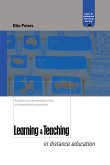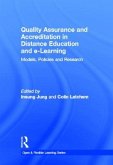Distance Education
International Perspectives
Herausgeber: Sewart, David; Holmberg, Borje; Keegan, Desmond
Distance Education
International Perspectives
Herausgeber: Sewart, David; Holmberg, Borje; Keegan, Desmond
- Gebundenes Buch
- Merkliste
- Auf die Merkliste
- Bewerten Bewerten
- Teilen
- Produkt teilen
- Produkterinnerung
- Produkterinnerung
Originally published in 1988, this book chronicles the great change in distance education. It presents the best writings on the subject published during the previous ten years. The articles selected for this volume provided a new scholarly basis for the theory and practice of distance education.
Andere Kunden interessierten sich auch für
![Distance Education Distance Education]() Distance Education222,99 €
Distance Education222,99 €![Basic Education at a Distance Basic Education at a Distance]() Chris Yates (ed.)Basic Education at a Distance60,99 €
Chris Yates (ed.)Basic Education at a Distance60,99 €![Learning and Teaching in Distance Education Learning and Teaching in Distance Education]() Otto PetersLearning and Teaching in Distance Education227,99 €
Otto PetersLearning and Teaching in Distance Education227,99 €![Theoretical Principles of Distance Education Theoretical Principles of Distance Education]() Theoretical Principles of Distance Education240,99 €
Theoretical Principles of Distance Education240,99 €![Quality Assurance and Accreditation in Distance Education and e-Learning Quality Assurance and Accreditation in Distance Education and e-Learning]() Insung JungQuality Assurance and Accreditation in Distance Education and e-Learning222,99 €
Insung JungQuality Assurance and Accreditation in Distance Education and e-Learning222,99 €![Reforming Open and Distance Education Reforming Open and Distance Education]() Terry Evans / Daryl Nation (eds.)Reforming Open and Distance Education149,99 €
Terry Evans / Daryl Nation (eds.)Reforming Open and Distance Education149,99 €![Collaboration in Distance Education Collaboration in Distance Education]() Louise Moran / Ian Mugridge (eds.)Collaboration in Distance Education53,99 €
Louise Moran / Ian Mugridge (eds.)Collaboration in Distance Education53,99 €-
-
-
Originally published in 1988, this book chronicles the great change in distance education. It presents the best writings on the subject published during the previous ten years. The articles selected for this volume provided a new scholarly basis for the theory and practice of distance education.
Produktdetails
- Produktdetails
- Verlag: Routledge
- Seitenzahl: 462
- Erscheinungstermin: 14. August 2020
- Englisch
- Abmessung: 222mm x 145mm x 28mm
- Gewicht: 708g
- ISBN-13: 9780367471460
- ISBN-10: 0367471469
- Artikelnr.: 75270533
- Herstellerkennzeichnung
- Libri GmbH
- Europaallee 1
- 36244 Bad Hersfeld
- gpsr@libri.de
- Verlag: Routledge
- Seitenzahl: 462
- Erscheinungstermin: 14. August 2020
- Englisch
- Abmessung: 222mm x 145mm x 28mm
- Gewicht: 708g
- ISBN-13: 9780367471460
- ISBN-10: 0367471469
- Artikelnr.: 75270533
- Herstellerkennzeichnung
- Libri GmbH
- Europaallee 1
- 36244 Bad Hersfeld
- gpsr@libri.de
David Sewart, Desmond Keegan and Börje Holmberg
Preface. Acknowledgements. Section 1: The Concept of Education
Introduction. On Defining Distance Education. A Theory for Distance
Education. Distance Teaching: A Contradiction in Terms? Section 2: Theories
of Distance Education Introduction. On a Theory of Independent Study.
Distance Teaching and Industrial Production: A Comparative Interpretation
in Outline. Guided Didactic Conversation in Distance Education. Section 3:
Distance Education and Society: A Rationale Introduction. Back Door
Learning in the Learning Society. Adverse Factors in the Development of an
Open University in Latin America. What Advantages Can Conventional
Education Derive from Correspondence Education? Section 4: Students and
their Progress Introduction. Student Demand and Progress at the Open
University - The First Eight Years. External Studies at New England - A
Silver Jubilee Review, 1955-1979. Research and Development Activities in
the Field of Distance Study at NKI-Skolen, Norway Section 5: Choice of
Medium: The New Communications Technology Introduction. Trends in the Use
of Audio-Visual Media in Distance Education Systems. Education by
Satellite: Australia Possibilities. On Choosing Teaching Methods to Match
Educational Aims Section 6: Course Development Introduction. A List of
Ideas for the Construction of Distance Educaiton Courses. The Student's
Freedom of Choice Within the Didactical Structure of a Correspondence
Course. Tell Me How to Write Section 7: Student Support Services
Introduction. Teaching for the Open University. Interaction and
Independence: Getting the Mixture Right. The Consultation in the Process of
Distance Education Section 8: Economics Introduction. The Economics of the
Open University Revisited. The Economics and Management of Small
Post-Secondary Distance Education Systems. Economics and Cost Structures.
Index.
Introduction. On Defining Distance Education. A Theory for Distance
Education. Distance Teaching: A Contradiction in Terms? Section 2: Theories
of Distance Education Introduction. On a Theory of Independent Study.
Distance Teaching and Industrial Production: A Comparative Interpretation
in Outline. Guided Didactic Conversation in Distance Education. Section 3:
Distance Education and Society: A Rationale Introduction. Back Door
Learning in the Learning Society. Adverse Factors in the Development of an
Open University in Latin America. What Advantages Can Conventional
Education Derive from Correspondence Education? Section 4: Students and
their Progress Introduction. Student Demand and Progress at the Open
University - The First Eight Years. External Studies at New England - A
Silver Jubilee Review, 1955-1979. Research and Development Activities in
the Field of Distance Study at NKI-Skolen, Norway Section 5: Choice of
Medium: The New Communications Technology Introduction. Trends in the Use
of Audio-Visual Media in Distance Education Systems. Education by
Satellite: Australia Possibilities. On Choosing Teaching Methods to Match
Educational Aims Section 6: Course Development Introduction. A List of
Ideas for the Construction of Distance Educaiton Courses. The Student's
Freedom of Choice Within the Didactical Structure of a Correspondence
Course. Tell Me How to Write Section 7: Student Support Services
Introduction. Teaching for the Open University. Interaction and
Independence: Getting the Mixture Right. The Consultation in the Process of
Distance Education Section 8: Economics Introduction. The Economics of the
Open University Revisited. The Economics and Management of Small
Post-Secondary Distance Education Systems. Economics and Cost Structures.
Index.
Preface. Acknowledgements. Section 1: The Concept of Education
Introduction. On Defining Distance Education. A Theory for Distance
Education. Distance Teaching: A Contradiction in Terms? Section 2: Theories
of Distance Education Introduction. On a Theory of Independent Study.
Distance Teaching and Industrial Production: A Comparative Interpretation
in Outline. Guided Didactic Conversation in Distance Education. Section 3:
Distance Education and Society: A Rationale Introduction. Back Door
Learning in the Learning Society. Adverse Factors in the Development of an
Open University in Latin America. What Advantages Can Conventional
Education Derive from Correspondence Education? Section 4: Students and
their Progress Introduction. Student Demand and Progress at the Open
University - The First Eight Years. External Studies at New England - A
Silver Jubilee Review, 1955-1979. Research and Development Activities in
the Field of Distance Study at NKI-Skolen, Norway Section 5: Choice of
Medium: The New Communications Technology Introduction. Trends in the Use
of Audio-Visual Media in Distance Education Systems. Education by
Satellite: Australia Possibilities. On Choosing Teaching Methods to Match
Educational Aims Section 6: Course Development Introduction. A List of
Ideas for the Construction of Distance Educaiton Courses. The Student's
Freedom of Choice Within the Didactical Structure of a Correspondence
Course. Tell Me How to Write Section 7: Student Support Services
Introduction. Teaching for the Open University. Interaction and
Independence: Getting the Mixture Right. The Consultation in the Process of
Distance Education Section 8: Economics Introduction. The Economics of the
Open University Revisited. The Economics and Management of Small
Post-Secondary Distance Education Systems. Economics and Cost Structures.
Index.
Introduction. On Defining Distance Education. A Theory for Distance
Education. Distance Teaching: A Contradiction in Terms? Section 2: Theories
of Distance Education Introduction. On a Theory of Independent Study.
Distance Teaching and Industrial Production: A Comparative Interpretation
in Outline. Guided Didactic Conversation in Distance Education. Section 3:
Distance Education and Society: A Rationale Introduction. Back Door
Learning in the Learning Society. Adverse Factors in the Development of an
Open University in Latin America. What Advantages Can Conventional
Education Derive from Correspondence Education? Section 4: Students and
their Progress Introduction. Student Demand and Progress at the Open
University - The First Eight Years. External Studies at New England - A
Silver Jubilee Review, 1955-1979. Research and Development Activities in
the Field of Distance Study at NKI-Skolen, Norway Section 5: Choice of
Medium: The New Communications Technology Introduction. Trends in the Use
of Audio-Visual Media in Distance Education Systems. Education by
Satellite: Australia Possibilities. On Choosing Teaching Methods to Match
Educational Aims Section 6: Course Development Introduction. A List of
Ideas for the Construction of Distance Educaiton Courses. The Student's
Freedom of Choice Within the Didactical Structure of a Correspondence
Course. Tell Me How to Write Section 7: Student Support Services
Introduction. Teaching for the Open University. Interaction and
Independence: Getting the Mixture Right. The Consultation in the Process of
Distance Education Section 8: Economics Introduction. The Economics of the
Open University Revisited. The Economics and Management of Small
Post-Secondary Distance Education Systems. Economics and Cost Structures.
Index.








